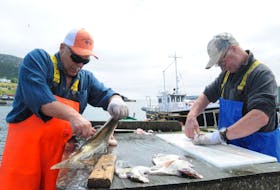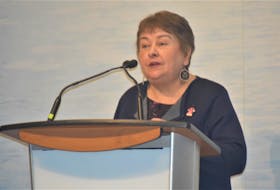ST. ANTHONY, N.L. — Eight people from the St. Anthony area attended a discussion hosted by the Office of Immigration and Multiculturalism director Debbie Sheppard.
What began as a learning session on immigration and statistics turned into a passionate discussion on how the province can help bring in more immigrants to work and live.
Each year, the province is allowed to nominate 1,050 individuals for immigration, with 550 of those being express entry positions of specialized training. A majority of those that find a new home in Newfoundland and Labrador go to the St. John’s area because of the services available, like the Centre for New Canadians.
But these numbers are not reflective of rural areas.
St. Anthony town manager Curtis Richards was an advocate for marketing the Northern Peninsula, and especially the service hub of St. Anthony, as an ideal place for families.
Noting that there are few young people staying in the area after high school, Richards says that it doesn’t make sense to target 20-year-olds to come to the region.
“I think when we target people to move to St. Anthony and region, we have to target a certain clientele,” he said. “Maybe we need to focus on the type of professional that wants to come to the community, someone, for example, who comes to work at the hospital and raise a family in a small community.
“We can’t keep our own children here, you almost have to get a family.”
It was echoed around the table, with people adding that both spouses should get an opportunity to work, even if only one has a specialized skill.
For Ambrose Pilgrim of St. Lunaire-Griquet, it was not a surprise that not a lot of young people were sticking around, but also that seniors leave as well.
“All the communities have to offer is work,” he said. “They have no social aspect.”
Sharon Kean, owner of Mary Browns in St. Anthony, would like to see more social activities as well, starting with the local pool.
She said the pool can target all age groups, and it would be just another thing to offer immigrants if it was open year round.
Eight people from the St. Anthony area attended a discussion hosted by the Office of Immigration and Multiculturalism director Debbie Sheppard.
What began as a learning session on immigration and statistics turned into a passionate discussion on how the province can help bring in more immigrants to work and live.
Each year, the province is allowed to nominate 1,050 individuals for immigration, with 550 of those being express entry positions of specialized training. A majority of those that find a new home in Newfoundland and Labrador go to the St. John’s area because of the services available, like the Centre for New Canadians.
But these numbers are not reflective of rural areas.
St. Anthony town manager Curtis Richards was an advocate for marketing the Northern Peninsula, and especially the service hub of St. Anthony, as an ideal place for families.
Noting that there are few young people staying in the area after high school, Richards says that it doesn’t make sense to target 20-year-olds to come to the region.
“I think when we target people to move to St. Anthony and region, we have to target a certain clientele,” he said. “Maybe we need to focus on the type of professional that wants to come to the community, someone, for example, who comes to work at the hospital and raise a family in a small community.
“We can’t keep our own children here, you almost have to get a family.”
It was echoed around the table, with people adding that both spouses should get an opportunity to work, even if only one has a specialized skill.
For Ambrose Pilgrim of St. Lunaire-Griquet, it was not a surprise that not a lot of young people were sticking around, but also that seniors leave as well.
“All the communities have to offer is work,” he said. “They have no social aspect.”
Sharon Kean, owner of Mary Browns in St. Anthony, would like to see more social activities as well, starting with the local pool.
She said the pool can target all age groups, and it would be just another thing to offer immigrants if it was open year round.

Decline
Earlier this year, a report from the Harris Centre at Memorial University was released, showing a dramatic decline in the population over the next 20 years for the Northern Peninsula and coastal Labrador.
This is something that Richards and other municipal leaders have spoken about since the report came out.
“The Harris report is a real eye-opener for a lot of us, and it scares us,” he explained. “It’s really scary for someone who has small children that would love to come back and live. Now, how can’t (anyone) support building a house in this region until we see what happens in five years time.”
Another thing that was discussed was marketing and branding the area to attract immigrants, especially ones that would prefer to be in a rural setting.
The safe atmosphere, the friendly people and recreational activities for children were just some of the benefits the group believed would help target people to rural areas.
One thing the group said was missing was the ability to provide the supports for those moving in to the area, including people to help with the English language, if needed, someone to organize social events for newcomers to the area and the ability to offer a welcome from the town and local organizations to individuals and families that come to the area.
“(The area) needs a good mentorship program,” Richards explained. “People that are going to take them to church, take them snowmobiling… or they’re going to feel alone.”
The biggest issue for that is privacy laws, that prevent names from being released to the town or others from employers or other organizations.
Richards had a suggestion that Sheppard had not heard in the other cross-province forums she hosted — the college as a site for mentorship and integration.
“It could be the focal point for them to go to,” he said, “You’ve got the resources, you’ve got the building, you’ve got the heat, you’ve got the light, you’ve got the instructors. Now all you have to do is send out a message to engage the community and engage the immigrants.”
The college has access to technology, instructors and resources that could be beneficial for this type of offering, he continued.
The general consensus of the meeting was there is a need for more resources and volunteers to help out with immigrants to the region, but also in order to match an immigrant to rural Newfoundland, there needs to be more done to promote the local area.
For details on immigration offerings for the province, visit www.nlimmigration.ca.









